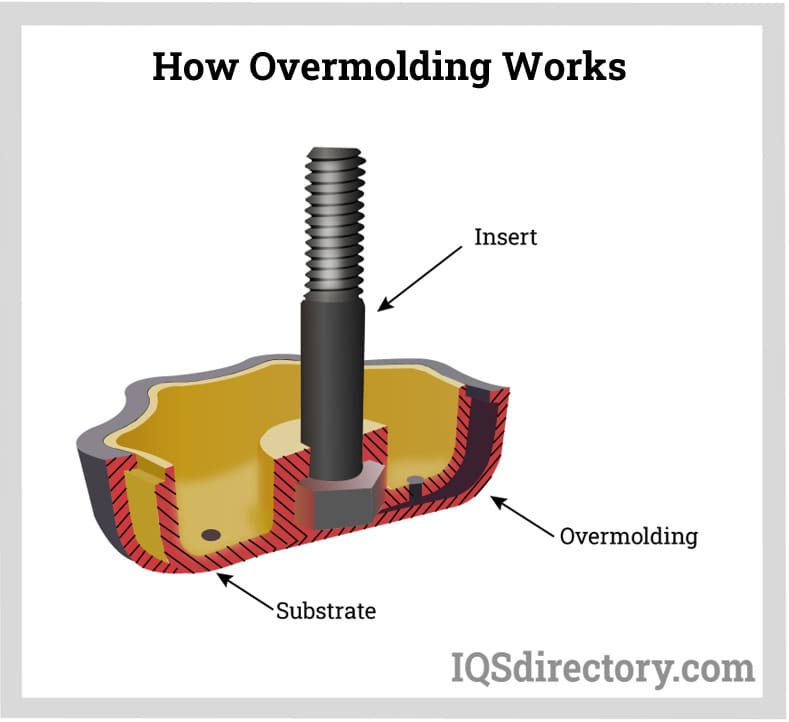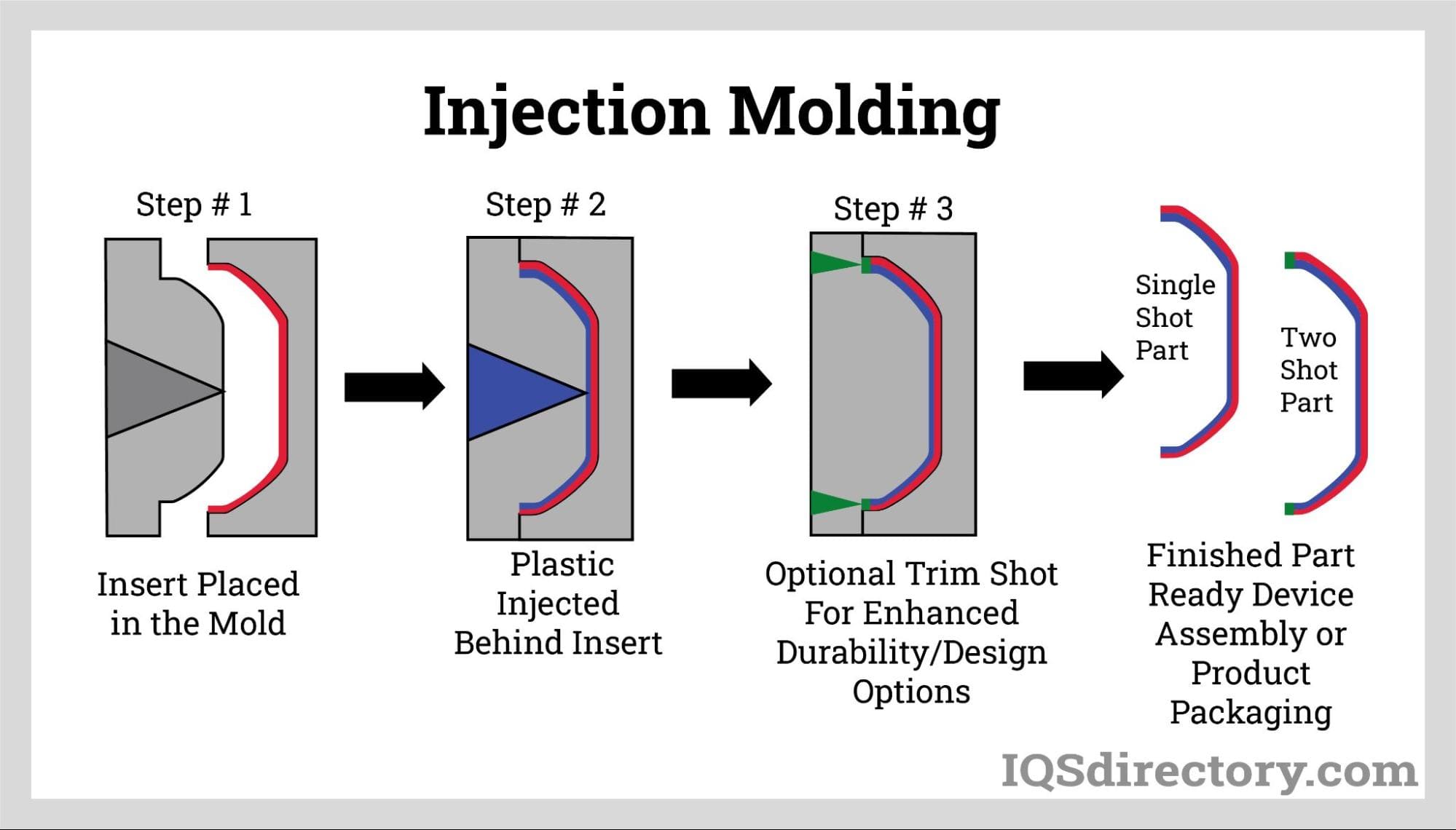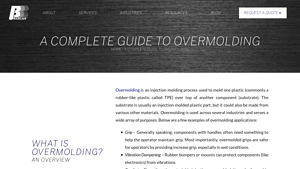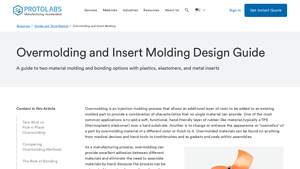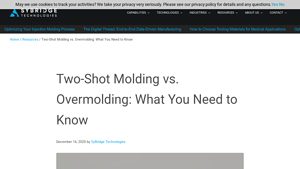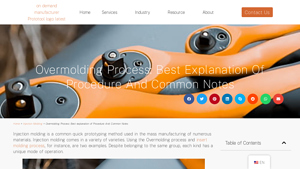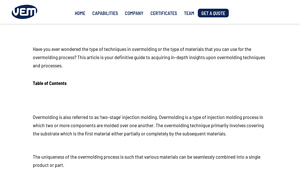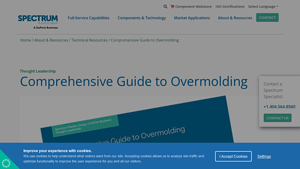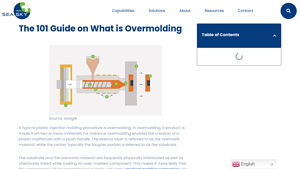Overmolding Process Guide: Type, Cost, Top List…
Introduction: Navigating the Global Market for overmolding process
In the competitive landscape of manufacturing, international B2B buyers often face the challenge of sourcing reliable and efficient overmolding processes that meet the diverse needs of their markets. Overmolding, an advanced injection molding technique, offers significant advantages in creating multi-material components that enhance product functionality and user experience. However, navigating the complexities of this process—including selecting the right materials, understanding production costs, and identifying reputable suppliers—can be daunting, especially for businesses in regions like Africa, South America, the Middle East, and Europe.
This comprehensive guide is designed to empower B2B buyers by providing in-depth insights into the overmolding process. We will explore various types of overmolding, their applications across industries, and the critical factors to consider when vetting suppliers. Additionally, we’ll discuss cost considerations and how to optimize your purchasing decisions to ensure the highest return on investment. By understanding these elements, buyers can make informed choices that align with their operational goals and market demands, ultimately leading to more effective product development and enhanced competitive advantage.
Whether you’re in Saudi Arabia, Nigeria, or elsewhere, this guide will serve as a valuable resource for navigating the global market for overmolding processes, equipping you with the knowledge needed to streamline your sourcing strategies and enhance your product offerings.
Understanding overmolding process Types and Variations
| Type Name | Key Distinguishing Features | Primary B2B Applications | Brief Pros & Cons for Buyers |
|---|---|---|---|
| Traditional Overmolding | Involves molding a second material over a substrate; often uses thermoplastic elastomers (TPE) for enhanced grip and comfort. | Consumer goods, medical devices, automotive components | Pros: Improved ergonomics, reduced assembly costs. Cons: High initial tooling costs, longer lead times. |
| Insert Molding | Uses pre-existing components as inserts, allowing for the embedding of metal or electronic parts within the plastic layer. | Electronics, automotive parts, medical devices | Pros: Stronger parts, diverse material options. Cons: Complex tooling requirements, potential for higher costs in low volumes. |
| Two-Shot Molding | A specialized form of overmolding where two different materials are molded in a single cycle, enhancing design flexibility. | High-end consumer products, specialized industrial applications | Pros: Streamlined production, multi-material capabilities. Cons: Requires precise machine calibration, higher upfront costs. |
| Soft Touch Overmolding | Focuses on creating soft-touch surfaces that enhance user experience, typically using TPE or silicone materials. | Handheld tools, consumer electronics, sports equipment | Pros: Increased comfort and grip, aesthetic appeal. Cons: Potential durability issues, specific material sourcing challenges. |
| Vibration Dampening Overmolding | Utilizes materials that absorb shock and vibrations, often in critical applications like electronics or automotive parts. | Electronics, automotive, industrial machinery | Pros: Enhanced product longevity, improved performance. Cons: Material selection complexity, may require specialized testing. |
What is Traditional Overmolding and When is it Suitable for B2B Buyers?
Traditional overmolding is a versatile process where a second layer, often made from TPE, is molded over a plastic substrate. This method is particularly suitable for consumer goods and medical devices that require enhanced grip or comfort. B2B buyers should consider the long-term production needs and potential cost savings in assembly, as traditional overmolding reduces the number of separate components. However, the initial tooling costs can be high, making it more feasible for larger production runs.
How Does Insert Molding Differ and What Are Its Key Applications?
Insert molding differentiates itself by using pre-existing components as inserts, allowing manufacturers to embed materials like metals or electronics within a plastic shell. This method is ideal for applications in electronics, automotive parts, and medical devices, where strength and protection are critical. B2B buyers should weigh the complexity of tooling against the benefits of creating strong, integrated parts. Although it offers diverse material options, the initial costs and complexity can be challenging for low-volume production.
What Advantages Does Two-Shot Molding Offer for Complex Designs?
Two-shot molding is a specialized overmolding technique that allows for the simultaneous molding of two different materials in a single cycle. This process is particularly beneficial for high-end consumer products and specialized industrial applications that require complex designs. B2B buyers should consider this method for projects that demand both aesthetic appeal and functional performance. While it streamlines production and enhances design flexibility, the higher upfront costs and need for precise machine calibration can be a barrier.
How Can Soft Touch Overmolding Enhance User Experience?
Soft touch overmolding focuses on creating surfaces that provide a tactile, comfortable grip, commonly using TPE or silicone materials. This technique is widely used in handheld tools, consumer electronics, and sports equipment. B2B buyers looking to enhance user experience should consider this method for its aesthetic and functional benefits. However, potential durability issues and the need for specific material sourcing can complicate the procurement process.
What Role Does Vibration Dampening Overmolding Play in Product Longevity?
Vibration dampening overmolding employs materials specifically designed to absorb shocks and vibrations, making it suitable for critical applications such as electronics and automotive components. B2B buyers should recognize the importance of enhanced product longevity and performance in their procurement decisions. While this method offers significant advantages, the complexity of material selection and the necessity for specialized testing can present challenges that require careful consideration.
Key Industrial Applications of overmolding process
| Industry/Sector | Specific Application of overmolding process | Value/Benefit for the Business | Key Sourcing Considerations for this Application |
|---|---|---|---|
| Consumer Electronics | Overmolded grips for handheld devices | Enhanced user comfort and safety through improved grip | Material selection for durability and ergonomics |
| Automotive | Overmolded components for vehicle interiors | Increased aesthetic appeal and noise reduction | Compliance with automotive standards and regulations |
| Medical Devices | Overmolded housings for surgical instruments | Improved hygiene and protection for sensitive components | Biocompatibility and sterilization capabilities |
| Industrial Equipment | Overmolded handles for tools and machinery | Enhanced grip and vibration dampening for operator safety | Material resistance to chemicals and environmental factors |
| Telecommunications | Overmolded casings for electronic enclosures | Increased durability and moisture resistance | Need for precision and compatibility with electronic components |
How is Overmolding Used in Consumer Electronics?
In the consumer electronics sector, overmolding is frequently applied to create ergonomic grips for handheld devices like smartphones and gaming controllers. The process combines a hard plastic substrate with a soft, rubber-like thermoplastic elastomer (TPE), resulting in a product that is not only comfortable to hold but also provides a non-slip surface. This is crucial for user safety, especially in humid environments. International buyers should consider the specific material properties required for durability and ergonomics, ensuring compliance with local regulations regarding electronic devices.
What Role Does Overmolding Play in the Automotive Industry?
In automotive manufacturing, overmolding is used to enhance vehicle interiors by applying soft-touch materials to hard plastic components. This results in a more aesthetically pleasing finish and contributes to sound dampening, enhancing the overall driving experience. For businesses in this sector, sourcing materials that meet automotive safety standards is essential. Additionally, understanding local market preferences for interior finishes can significantly impact product acceptance and sales.
Why is Overmolding Important for Medical Devices?
Overmolding is critical in the medical device industry, particularly for creating protective housings for surgical instruments and implants. The process allows for the integration of soft, biocompatible materials that provide comfort and safety for patients. For international B2B buyers, ensuring that materials meet strict biocompatibility and sterilization standards is vital for compliance and patient safety. This attention to detail can significantly influence marketability in various regions, especially where healthcare regulations are stringent.
How Does Overmolding Enhance Industrial Equipment?
In industrial equipment, overmolding is utilized to create handles for tools and machinery, providing a secure grip that reduces operator fatigue and enhances safety. The combination of materials in overmolding can also dampen vibrations, which is particularly beneficial in high-use environments. Buyers in this sector should focus on sourcing materials that are resistant to chemicals and environmental factors, as these can impact the longevity and performance of the tools in challenging conditions.
What Benefits Does Overmolding Provide in Telecommunications?
In the telecommunications industry, overmolding is often employed to manufacture durable casings for electronic enclosures, protecting sensitive components from environmental damage. The overmolding process can add moisture resistance and impact protection, which is critical for devices used in various climates. Businesses should prioritize sourcing precision-engineered components that ensure compatibility with existing electronic parts, as well as materials that can withstand the rigors of outdoor use.
3 Common User Pain Points for ‘overmolding process’ & Their Solutions
Scenario 1: High Production Costs Due to Complex Tooling
The Problem: B2B buyers often encounter steep initial costs when utilizing the overmolding process. The complexity of designing and manufacturing tooling, especially in regions with limited access to advanced manufacturing technologies, can be a significant barrier. Buyers may find themselves facing high upfront expenses that can hinder their ability to scale production effectively, leading to a reluctance to invest in overmolding despite its long-term benefits.
The Solution: To mitigate these costs, buyers should consider investing in 3D printing for prototyping their molds. By utilizing additive manufacturing technologies, companies can create custom molds quickly and at a fraction of the cost of traditional metal tooling. This approach allows for rapid iterations and adjustments before committing to the final production tooling. Additionally, collaborating with local suppliers who specialize in rapid prototyping can reduce lead times and costs associated with shipping and logistics. Establishing clear communication about design specifications and production goals will further optimize the prototyping process, ensuring that the final molds meet the exact requirements for overmolding.
Scenario 2: Material Compatibility Issues Affecting Product Quality
The Problem: Another prevalent pain point for B2B buyers is the challenge of ensuring compatibility between the substrate and the overmold material. Using incompatible materials can result in poor adhesion, leading to product failures, increased warranty claims, and a damaged reputation. Buyers may struggle to identify the right materials, especially when dealing with diverse applications across various industries.
The Solution: To overcome material compatibility issues, buyers should conduct thorough research and testing prior to production. Engaging with material suppliers who offer comprehensive material data sheets can provide insights into the physical and chemical properties of potential materials. Conducting small-scale trials that involve actual production scenarios can help identify the best material combinations. Furthermore, leveraging the expertise of experienced engineers during the design phase can ensure that the selected materials not only meet functional requirements but also exhibit optimal adhesion properties. Documenting these trials and findings can also serve as a valuable reference for future projects.
Scenario 3: Difficulty in Achieving Design Precision and Consistency
The Problem: Achieving precision and consistency in the overmolding process can be particularly challenging, especially for B2B buyers producing complex geometries or multi-material products. Variations in wall thickness, improper gate location, and inadequate sealing features can lead to defects, wastage, and increased cycle times. This inconsistency not only affects product quality but also can result in costly rework and delays in product launches.
The Solution: To enhance design precision, buyers should prioritize a comprehensive design review process that includes simulation and analysis tools. Utilizing software that can simulate the injection molding process allows for the identification of potential issues before production begins. Implementing strict design guidelines, such as maintaining uniform wall thickness and optimizing gate locations, can significantly reduce defects. Additionally, collaborating with experienced mold designers who understand the nuances of overmolding will ensure that the mold design is robust and suited to the specific production requirements. Regular communication with manufacturing teams during the design phase can also help address any potential issues early on, ensuring a smoother transition to full-scale production.
Strategic Material Selection Guide for overmolding process
What Are the Key Properties of Common Materials Used in Overmolding?
When selecting materials for the overmolding process, it is crucial to consider their properties, advantages, and limitations to ensure optimal performance in the intended application. Here, we analyze four commonly used materials: Thermoplastic Elastomers (TPE), Polypropylene (PP), Polycarbonate (PC), and Silicone (SI).
How Do Thermoplastic Elastomers (TPE) Perform in Overmolding?
TPEs are rubber-like materials that combine the processing advantages of plastics with the flexibility of rubber. They exhibit excellent elasticity, resilience, and durability, making them ideal for applications requiring a soft touch or grip. TPEs can withstand temperatures ranging from -40°C to 120°C, providing good thermal stability.
Pros: TPEs are cost-effective, easy to process, and can be colored easily, enhancing aesthetic appeal. They also offer good chemical resistance, making them suitable for various environments.
Cons: While TPEs are versatile, they may not be suitable for high-temperature applications or environments with harsh chemicals, which could lead to degradation over time.
Impact on Application: TPEs are commonly used for grips, seals, and cushioning components. Their compatibility with a wide range of media makes them suitable for consumer goods, medical devices, and automotive applications.
Considerations for International Buyers: Compliance with standards such as ASTM and ISO is essential. Buyers from regions like Africa and the Middle East should ensure that TPEs meet local regulations regarding safety and environmental impact.
What Advantages Does Polypropylene (PP) Offer for Overmolding?
Polypropylene is a widely used thermoplastic known for its excellent chemical resistance and low-density properties. It can withstand temperatures up to 100°C and has good impact resistance, making it suitable for various applications.
Pros: PP is lightweight, cost-effective, and offers excellent durability. Its resistance to moisture and chemicals makes it ideal for packaging and automotive parts.
Cons: The main limitation of PP is its low-temperature resistance; it may become brittle in extremely cold conditions. Additionally, its surface can be challenging to bond with other materials during the overmolding process.
Impact on Application: PP is often used in applications requiring lightweight components, such as automotive interiors and consumer goods. Its compatibility with various media enhances its versatility.
Considerations for International Buyers: Buyers should consider local standards for food safety and environmental regulations, especially in regions like South America, where compliance can vary significantly.
How Does Polycarbonate (PC) Enhance Overmolding Applications?
Polycarbonate is a strong, transparent thermoplastic known for its high impact resistance and optical clarity. It can withstand temperatures up to 135°C and offers excellent dimensional stability.
Pros: PC is highly durable and resistant to UV radiation, making it suitable for outdoor applications. Its strength and transparency make it ideal for protective covers and lenses.
Cons: The primary drawback of PC is its higher cost compared to other plastics, and it may require special processing conditions due to its viscosity.
Impact on Application: PC is commonly used in applications where clarity and strength are essential, such as in medical devices and safety equipment.
Considerations for International Buyers: Compliance with international standards for medical devices and safety equipment is crucial. Buyers in Europe and the Middle East should ensure that PC materials meet relevant regulations.
What Role Does Silicone (SI) Play in Overmolding?
Silicone is a versatile material known for its flexibility, heat resistance, and biocompatibility. It can withstand temperatures from -60°C to 200°C, making it suitable for high-temperature applications.
Pros: Silicone is highly resistant to extreme temperatures, UV light, and ozone, which enhances its longevity. Its biocompatibility makes it ideal for medical applications.
Cons: Silicone can be more expensive than other materials, and its processing can be complex, requiring specialized equipment.
Impact on Application: Silicone is often used in applications requiring high-performance seals, gaskets, and medical devices due to its superior properties.
Considerations for International Buyers: Buyers should ensure that silicone materials comply with international medical device standards and environmental regulations, especially in regions like Africa and South America.
Summary Table of Material Selection for Overmolding
| Material | Typical Use Case for overmolding process | Key Advantage | Key Disadvantage/Limitation | Relative Cost (Low/Med/High) |
|---|---|---|---|---|
| Thermoplastic Elastomers (TPE) | Grips, seals, cushioning components | Excellent elasticity and durability | Limited high-temperature resistance | Medium |
| Polypropylene (PP) | Automotive interiors, consumer goods | Lightweight and cost-effective | Low-temperature brittleness | Low |
| Polycarbonate (PC) | Medical devices, protective covers | High impact resistance and clarity | Higher processing costs | High |
| Silicone (SI) | Seals, gaskets, medical devices | Superior temperature resistance | Higher material and processing costs | High |
In-depth Look: Manufacturing Processes and Quality Assurance for overmolding process
What Are the Main Stages of the Overmolding Manufacturing Process?
The overmolding process involves several critical stages that ensure the production of high-quality components. Understanding these stages is essential for B2B buyers looking to optimize their manufacturing operations.
1. Material Preparation
Material preparation is the initial phase in the overmolding process. It involves selecting the appropriate substrates and overmolding materials based on the desired properties of the final product. Common materials for substrates include various thermoplastics like ABS, Nylon, and Polycarbonate, while thermoplastic elastomers (TPE) are typically used for the overmolding layer.
This stage also includes drying and conditioning the materials to ensure they meet specific moisture content requirements. Proper material preparation is crucial as it directly affects the adhesion between the substrate and the overmolded material, impacting the durability and performance of the final product.
2. Forming: The Core of the Overmolding Process
The forming stage consists of two key steps: injection molding of the substrate and the overmolding process itself.
-
Injection Molding of the Substrate: In this step, the substrate material is heated and injected into a mold, where it takes the shape of the desired component. This mold design is critical as it determines the flow of the material and the final part’s geometry.
-
Overmolding: Once the substrate has cooled and solidified, the overmolding material is injected into the same mold. This step can be done in a single machine setup (two-shot molding) or in a sequential process where the substrate is transferred to a different mold. The choice between these methods depends on factors like production volume and complexity of the part design.
3. Assembly: Ensuring Component Integrity
Assembly in the overmolding context primarily involves ensuring that the overmolded layer adheres correctly to the substrate. While this may seem straightforward, it requires careful control over process parameters such as temperature, pressure, and injection speed to avoid defects like delamination or incomplete filling.
For complex assemblies, additional steps may include the integration of inserts, such as metal components or electronics, which can enhance functionality while being encapsulated in the overmolded material.
4. Finishing: Final Touches for Quality Assurance
The finishing stage can include various processes depending on the product requirements. This may involve trimming excess material, surface treatment, and painting or coating to enhance aesthetics and functionality.
Quality checks during this stage are critical to ensure that the part meets design specifications and industry standards. This may also include preparing the product for packaging and shipment, ensuring that it is ready for the end-user.
What Quality Assurance Standards Should B2B Buyers Consider?
Quality assurance (QA) is a vital part of the overmolding process, ensuring that products meet both international and industry-specific standards. B2B buyers must be well-versed in these QA measures to ensure they partner with reputable suppliers.
Relevant International Standards: ISO 9001 and Beyond
ISO 9001 is the most recognized quality management standard globally and serves as a foundation for quality assurance across various industries. Compliance with ISO 9001 indicates that a manufacturer has established a quality management system (QMS) that consistently meets customer and regulatory requirements.
In addition to ISO 9001, industry-specific certifications may be relevant, such as:
- CE Marking: Required for products sold in the European Economic Area, indicating compliance with health, safety, and environmental protection standards.
- API Certification: Important in the oil and gas sector, ensuring that products meet specific quality and safety standards.
What Are the QC Checkpoints in the Overmolding Process?
Quality control (QC) checkpoints are essential for maintaining product integrity throughout the manufacturing process. These checkpoints can be classified into three main categories:
-
Incoming Quality Control (IQC): This involves inspecting raw materials and components upon arrival at the manufacturing facility. Ensuring that materials meet specified standards is crucial for preventing defects in the final product.
-
In-Process Quality Control (IPQC): During the manufacturing process, regular inspections are conducted to monitor parameters such as temperature, pressure, and material flow. This step helps identify potential issues early, allowing for timely adjustments.
-
Final Quality Control (FQC): Once the manufacturing process is complete, the final products undergo rigorous testing to ensure they meet design specifications and quality standards. This may include visual inspections, dimensional checks, and functional testing.
How Can B2B Buyers Verify Supplier Quality Control?
For B2B buyers, verifying a supplier’s quality control practices is paramount to ensuring product reliability. Here are several strategies to assess supplier QC:
Conducting Supplier Audits
Regular audits of potential suppliers can provide insights into their quality management systems, production processes, and compliance with industry standards. Audits should focus on evaluating documentation, processes, and employee training related to quality assurance.
Requesting Quality Reports
B2B buyers can request detailed quality reports from suppliers, which should include data on defect rates, testing procedures, and compliance with relevant standards. This transparency helps buyers assess the supplier’s commitment to quality.
Engaging Third-Party Inspectors
In many cases, engaging third-party inspection services can provide an unbiased evaluation of the supplier’s manufacturing processes and product quality. These inspections can be particularly beneficial for international buyers who may not have the resources to conduct on-site audits.
What Are the QC and Certification Nuances for International Buyers?
International B2B buyers, especially those from regions like Africa, South America, the Middle East, and Europe, should be aware of specific nuances related to quality control and certification:
-
Understanding Regional Standards: Different regions may have varying regulatory requirements and standards. Buyers must familiarize themselves with these to ensure compliance and avoid potential legal issues.
-
Cultural Differences in Business Practices: Different cultures may approach quality assurance and business negotiations differently. Understanding these nuances can facilitate smoother interactions and strengthen supplier relationships.
-
Logistics and Supply Chain Considerations: International shipping can introduce additional quality risks. Buyers should consider how suppliers manage logistics and ensure that products maintain their quality throughout the supply chain.
By understanding the manufacturing processes and quality assurance practices associated with overmolding, B2B buyers can make informed decisions, ensuring they select suppliers capable of delivering high-quality products that meet their specific needs.
Practical Sourcing Guide: A Step-by-Step Checklist for ‘overmolding process’
Introduction
This guide serves as a practical checklist for B2B buyers interested in procuring the overmolding process. Overmolding can enhance product functionality and aesthetics, making it essential to approach the sourcing process methodically. By following these steps, you will ensure a successful procurement experience that aligns with your project requirements.
Step 1: Define Your Technical Specifications
Establishing clear technical specifications is crucial before initiating your sourcing process. This includes understanding the materials you require, the dimensions of the components, and the intended application of the overmolded product. Well-defined specifications will help you communicate effectively with potential suppliers and ensure they can meet your needs.
- Material Selection: Determine the types of plastics or elastomers you need, such as TPE or silicone, based on the desired properties of the final product.
- Performance Requirements: Identify any specific performance criteria, such as UV resistance or grip enhancement, that the overmolded part must fulfill.
Step 2: Research Potential Suppliers
Conduct thorough research to identify suppliers that specialize in overmolding. Look for companies with a proven track record in your industry, as experience can significantly impact the quality and reliability of the end product.
- Industry Experience: Prioritize suppliers who have successfully completed projects similar to yours.
- Customer Reviews: Examine testimonials and case studies to gauge the supplier’s reputation and customer satisfaction levels.
Step 3: Evaluate Supplier Capabilities
Before committing to a supplier, assess their technical capabilities and production processes. This evaluation will help ensure they can meet your specific requirements.
- Machinery and Technology: Confirm that the supplier has the necessary machinery and technology for overmolding, including two-shot molding capabilities.
- Quality Control Measures: Inquire about their quality assurance processes to ensure they can deliver consistent, high-quality parts.
Step 4: Request Samples and Prototypes
Requesting samples or prototypes is a critical step in the sourcing process. This allows you to evaluate the quality of the supplier’s work firsthand and assess how well they can meet your specifications.
- Material Samples: Ask for samples of the materials they intend to use, ensuring they align with your performance criteria.
- Prototype Evaluation: If possible, request a prototype of your design to assess fit, finish, and functionality before full production.
Step 5: Verify Compliance and Certifications
Ensure that the supplier adheres to relevant industry standards and possesses necessary certifications. Compliance with international standards is essential, especially for markets in regions like Europe and the Middle East.
- ISO Certifications: Check for ISO certifications that indicate adherence to quality management standards.
- Material Safety Standards: Verify that the materials used comply with safety regulations applicable in your target markets.
Step 6: Negotiate Terms and Pricing
Once you have identified a suitable supplier, engage in negotiations to finalize terms and pricing. Clear communication about expectations, lead times, and payment terms is vital.
- Volume Discounts: Discuss pricing based on your order volume to secure the best deal.
- Lead Times: Ensure you are aware of the production lead times to plan your project timeline accordingly.
Step 7: Establish a Communication Plan
Effective communication is key to a successful partnership with your supplier. Establish a clear communication plan that outlines how you will interact throughout the production process.
- Regular Updates: Schedule regular check-ins to monitor progress and address any issues that may arise.
- Point of Contact: Designate a primary contact person on both sides to streamline communication and ensure accountability.
By following this checklist, you will be well-equipped to navigate the complexities of sourcing overmolding services and ensure a successful outcome for your project.
Comprehensive Cost and Pricing Analysis for overmolding process Sourcing
What Are the Key Cost Components of the Overmolding Process?
When sourcing overmolding services, understanding the cost structure is vital for international B2B buyers. The primary cost components include:
-
Materials: The choice of substrate and overmolding materials significantly affects pricing. Common materials like ABS, TPE, and silicone vary in cost based on their properties and availability. Buyers should consider not only the initial material costs but also their durability and performance in the intended application.
-
Labor: Labor costs encompass skilled technicians required for setup, operation, and quality control. Regions with higher labor costs can impact the overall pricing structure. For buyers in Africa and South America, understanding local labor market conditions can help in negotiating better rates.
-
Manufacturing Overhead: This includes costs related to utilities, maintenance, and administrative expenses associated with production. It’s essential to evaluate how these overheads are factored into the pricing by potential suppliers.
-
Tooling: Overmolding typically requires specialized tooling for the injection molds. Tooling costs can be substantial, especially for custom designs. Suppliers may amortize these costs over production runs, making it critical for buyers to discuss expected order volumes.
-
Quality Control (QC): Ensuring that products meet specifications involves quality assurance processes that add to the overall cost. Buyers should inquire about the QC measures in place and how they impact pricing.
-
Logistics: Shipping and handling costs can vary widely based on geographic location and chosen Incoterms. Understanding these costs is crucial, especially for international transactions.
-
Margin: Suppliers will include a profit margin in their pricing. This margin can vary depending on the supplier’s market positioning, competition, and service offerings.
How Do Price Influencers Impact Overmolding Costs?
Several factors influence the pricing of overmolding services:
-
Volume/MOQ: Minimum order quantities (MOQs) and volume discounts can significantly affect pricing. Suppliers often provide better rates for larger orders, making it essential for buyers to forecast their needs accurately.
-
Specifications and Customization: Custom designs or complex specifications can drive up costs. Buyers should prepare detailed requirements to avoid unexpected charges later in the process.
-
Material Selection: The choice of materials can lead to varying price points. More advanced materials with enhanced properties may incur higher costs but could offer better performance or longevity.
-
Quality and Certifications: Products requiring specific industry certifications or higher quality standards may come with increased costs. Buyers should ensure their suppliers can meet these requirements without excessive markups.
-
Supplier Factors: The supplier’s reputation, experience, and geographical location can influence pricing. Established suppliers may charge more but can offer reliability and quality assurance.
-
Incoterms: The chosen Incoterms can affect logistics costs and responsibilities, influencing the total landed cost of the products.
What Are the Best Tips for Negotiating Overmolding Costs?
For international B2B buyers, particularly in regions like Africa, South America, the Middle East, and Europe, several negotiation strategies can lead to more favorable pricing:
-
Understand Total Cost of Ownership (TCO): Evaluate not just the upfront costs but the long-term implications of sourcing overmolded products. Consider durability, maintenance, and potential failure costs.
-
Leverage Volume Discounts: If possible, commit to larger orders to negotiate lower prices per unit. This can also lead to better payment terms.
-
Request Detailed Quotes: Ask suppliers for itemized quotes to understand where costs are coming from. This transparency can help in identifying areas for negotiation.
-
Explore Multiple Suppliers: Don’t settle for the first quote. Engaging multiple suppliers can provide leverage in negotiations and a clearer picture of market pricing.
-
Be Aware of Pricing Nuances: Different regions may have varying pricing structures influenced by local economic conditions. Understanding these nuances can aid in making informed sourcing decisions.
-
Build Long-Term Relationships: Establishing a good rapport with suppliers can lead to better pricing, priority service, and improved communication over time.
Disclaimer on Indicative Prices
It is important to note that prices for overmolding services can vary widely based on the factors mentioned above. Buyers should conduct thorough market research and obtain multiple quotes to ensure they are getting competitive pricing tailored to their specific needs.
Alternatives Analysis: Comparing overmolding process With Other Solutions
Exploring Alternatives to Overmolding: A Comparative Analysis
When evaluating manufacturing techniques, it’s essential to consider viable alternatives to the overmolding process. Each method offers distinct advantages and may better suit specific applications, depending on the product requirements and operational constraints. Below, we explore how overmolding compares with two alternatives: insert molding and traditional assembly.
| Comparison Aspect | Overmolding Process | Insert Molding | Traditional Assembly |
|---|---|---|---|
| Performance | Excellent for multi-material parts; enhances grip, comfort, and durability. | Strong integration of components; ideal for embedding electronics. | Flexible design; allows for complex assemblies. |
| Cost | Higher upfront tooling costs; cost-effective for large runs. | Similar tooling costs; economical for medium to large production. | Lower initial costs; can be expensive for high volumes due to labor. |
| Ease of Implementation | Requires specific machinery and design adjustments; complex setup. | Moderate complexity; requires precise placement of inserts. | Generally easier; can use standard tools and processes. |
| Maintenance | Requires careful maintenance of molds; potential for wear. | Moderate maintenance; less wear on molds due to fewer components. | Low maintenance; easy to replace individual components. |
| Best Use Case | Ideal for ergonomic grips, seals, and vibration dampening products. | Best for protective casings and electronic embedding applications. | Suitable for varied products needing customization and flexibility. |
In-Depth Analysis of Alternatives
What Are the Benefits and Limitations of Insert Molding?
Insert molding is a specialized form of injection molding that involves placing a pre-formed part into a mold before injecting plastic around it. This method excels in applications where components need to be securely joined without additional assembly steps. The primary advantage is the ability to embed various materials, such as metals or electronics, within a plastic casing, enhancing durability and functionality. However, insert molding requires precise alignment of the inserts, which can complicate the manufacturing process. Additionally, tooling costs can be substantial, similar to overmolding, making it less ideal for low-volume production.
How Does Traditional Assembly Compare to Overmolding?
Traditional assembly involves joining multiple components after they have been manufactured separately. This method offers great flexibility and is well-suited for products that may require frequent design changes or custom configurations. The initial costs are generally lower, and assembly processes can be adapted to various production scales. However, as production volumes increase, labor costs can become a significant factor, potentially negating the initial cost benefits. Traditional assembly may also result in weaker joints compared to the integrated design achieved through overmolding.
Making the Right Choice for Your Manufacturing Needs
Selecting the appropriate manufacturing method hinges on several factors, including production volume, product complexity, and material requirements. For projects requiring a robust, integrated design with excellent grip and durability, overmolding stands out as a premier choice. Conversely, if embedding components or using a variety of materials is critical, insert molding may be more advantageous. Traditional assembly is best suited for projects that prioritize flexibility and customization, especially when lower volumes are involved.
B2B buyers should weigh these factors carefully, considering both the long-term implications of their choice and the specific demands of their products. By thoroughly understanding the strengths and limitations of each method, businesses can make informed decisions that align with their operational goals and market needs.
Essential Technical Properties and Trade Terminology for overmolding process
What Are the Key Technical Properties of the Overmolding Process?
Understanding the essential technical properties of the overmolding process is crucial for B2B buyers, especially those looking to optimize product design and manufacturing efficiency. Here are some critical specifications to consider:
-
Material Grade
– The choice of material significantly impacts the performance and durability of overmolded products. Common materials include thermoplastic elastomers (TPE), which provide flexibility and grip, and ABS for structural integrity. Selecting the right grade ensures compatibility with the intended application, whether it’s for consumer goods or industrial components. -
Tolerance
– Tolerance refers to the permissible limit of variation in a physical dimension. In overmolding, maintaining tight tolerances is essential for ensuring that the overmolded layers bond effectively and function as intended. Precision in tolerance reduces the risk of defects, minimizing rework and enhancing product reliability. -
Wall Thickness
– Consistent wall thickness is vital in the overmolding process to ensure uniform material flow and structural integrity. Variations can lead to weak points, defects, and increased cycle times. Buyers should specify wall thickness requirements early in the design phase to prevent production delays and ensure product quality. -
Cycle Time
– Cycle time is the duration it takes to complete one production cycle, from injection to cooling. Shorter cycle times can lead to increased production efficiency and lower costs. Understanding cycle time is crucial for B2B buyers, as it directly affects lead times and overall project timelines. -
Adhesion Properties
– The adhesion between the substrate and the overmolded material is critical for the durability and performance of the final product. Poor adhesion can result in delamination, leading to product failure. Selecting materials with compatible surface energies and optimizing mold design can enhance adhesion.
What Are Common Trade Terms in Overmolding?
Familiarity with industry jargon is essential for effective communication in the overmolding sector. Here are some common trade terms:
-
OEM (Original Equipment Manufacturer)
– An OEM refers to a company that manufactures products or components that are sold by another company under its brand. In the context of overmolding, OEMs often require specific material and design specifications to meet their branding and functional requirements. -
MOQ (Minimum Order Quantity)
– MOQ indicates the smallest quantity of a product that a supplier is willing to sell. Understanding MOQ is crucial for buyers as it affects inventory levels and purchasing strategies. Larger MOQs can lead to cost savings but may also require significant upfront investment. -
RFQ (Request for Quotation)
– An RFQ is a document used by buyers to solicit price quotes from suppliers for specific products or services. It typically includes detailed specifications, quantities, and delivery timelines. Crafting a comprehensive RFQ helps ensure accurate and competitive pricing from manufacturers. -
Incoterms (International Commercial Terms)
– Incoterms are standardized trade terms that define the responsibilities of buyers and sellers regarding the shipping and delivery of goods. Familiarity with Incoterms helps B2B buyers understand shipping costs, insurance, and risk management, facilitating smoother international transactions. -
Lead Time
– Lead time is the period from the initiation of a project to its completion. In the overmolding process, lead time is influenced by factors like material sourcing, tooling design, and production schedules. Understanding lead time is essential for buyers to manage project timelines effectively.
By grasping these technical properties and trade terms, B2B buyers can make informed decisions that enhance product quality and streamline the procurement process in the overmolding industry.
Navigating Market Dynamics and Sourcing Trends in the overmolding process Sector
What Are the Current Market Dynamics and Key Trends in the Overmolding Process?
The global overmolding market is experiencing significant growth, driven by increasing demand for durable, multi-material components across diverse industries, including automotive, electronics, and medical devices. Key factors fueling this trend include the rise in consumer electronics, which often require ergonomic and aesthetically pleasing designs, and the automotive sector’s shift towards lightweight, composite materials to improve fuel efficiency. Additionally, emerging markets in Africa, South America, the Middle East, and Europe are witnessing a surge in manufacturing capabilities, allowing local businesses to adopt advanced overmolding technologies.
International B2B buyers should pay close attention to technological advancements such as the integration of 3D printing in the prototyping phase. This innovation not only reduces lead times but also minimizes costs associated with traditional tooling. Moreover, buyers should be aware of the increasing importance of customization and flexibility in production runs, which aligns with the growing trend of personalized consumer products.
The overmolding market is also seeing a shift towards digitalization, with Industry 4.0 principles being adopted in manufacturing processes to enhance efficiency and reduce waste. This digital transformation allows for real-time monitoring and data-driven decision-making, which can significantly improve supply chain management and responsiveness to market changes.
How Can Sustainability and Ethical Sourcing Impact the Overmolding Process?
Sustainability is becoming a critical consideration for B2B buyers in the overmolding sector. The environmental impact of manufacturing processes, particularly in terms of waste generation and resource consumption, is under scrutiny. As a result, companies are increasingly seeking suppliers that prioritize sustainable practices, such as using recycled materials or biodegradable plastics in their overmolding processes.
Ethical sourcing is equally important, as buyers are now more aware of the implications of their supply chain choices. Partnering with suppliers who maintain fair labor practices and adhere to environmental regulations can enhance a company’s reputation and align with consumer expectations. Certifications such as ISO 14001 for environmental management and OEKO-TEX for textiles can provide assurance of a supplier’s commitment to sustainability.
Moreover, the demand for “green” materials is growing, with thermoplastic elastomers (TPE) and other eco-friendly materials gaining popularity for their performance and reduced environmental footprint. International buyers must evaluate their suppliers not only based on cost and quality but also on their sustainability credentials to meet regulatory requirements and consumer demands.
What Is the Brief Evolution of the Overmolding Process in B2B Manufacturing?
The overmolding process has evolved significantly since its inception in the mid-20th century. Initially used primarily in consumer goods, the technique has expanded its applications to various sectors, including automotive and medical manufacturing. Early methods focused on simple designs, but advancements in injection molding technology have enabled more complex and precise components.
The introduction of computer-aided design (CAD) and simulation tools in the 1980s revolutionized the overmolding process, allowing for better design optimization and faster iterations. As global manufacturing demands increased, so did the need for efficient production methods, leading to the rise of multi-material overmolding solutions that enhance product functionality and aesthetics.
Today, the overmolding process is recognized for its ability to create robust, multi-functional parts that reduce assembly time and costs. This evolution reflects broader trends in manufacturing towards efficiency, customization, and sustainability, positioning overmolding as a vital technology for modern B2B buyers seeking competitive advantages in their products.
Frequently Asked Questions (FAQs) for B2B Buyers of overmolding process
-
How do I choose the right material for overmolding?
Selecting the appropriate material for overmolding is crucial for achieving the desired functionality and durability. Consider factors such as the part’s application, environmental exposure, and user interaction. Common materials include thermoplastic elastomers (TPE) for grip and comfort, and ABS or nylon for structural integrity. Additionally, consult with suppliers who can provide insights based on their experience with various applications and material properties. Ensuring compatibility between the base material and the overmold material will enhance adhesion and performance. -
What is the best overmolding technique for my product design?
The ideal overmolding technique depends on your specific product requirements and design complexity. Two-shot molding is effective for creating intricate designs with seamless transitions between materials, while traditional overmolding is suitable for simpler applications. Assess the intended use of your product, production volume, and budget constraints. Collaborating with a supplier who specializes in overmolding can provide tailored recommendations based on their expertise and available technologies. -
What are the typical lead times for overmolding projects?
Lead times for overmolding projects can vary widely based on factors such as design complexity, material selection, and production volume. Generally, expect a timeframe of 4 to 12 weeks from design finalization to delivery, with prototyping taking additional time. For large orders, production time may extend due to tooling requirements. To ensure timely delivery, maintain clear communication with your supplier and establish project milestones to track progress. -
How do I evaluate and vet overmolding suppliers?
Evaluating suppliers for overmolding requires a thorough assessment of their capabilities, experience, and reliability. Start by examining their portfolio for relevant projects and industry experience. Request references from previous clients to gauge satisfaction levels and on-time delivery rates. Additionally, consider their manufacturing processes, quality assurance protocols, and certifications. A reputable supplier should be willing to share information about their equipment, materials, and production capabilities. -
What are the minimum order quantities (MOQs) for overmolding?
Minimum order quantities for overmolding can vary depending on the supplier and the complexity of the project. Generally, MOQs may range from a few hundred to several thousand units. Factors influencing MOQs include production setup costs, tooling requirements, and material availability. When discussing your project with potential suppliers, clarify their MOQ policies and explore options for lower MOQs if you have specific budget constraints or are testing a new product. -
What payment terms should I expect when sourcing overmolding services?
Payment terms for overmolding services can differ significantly between suppliers and regions. Common practices include upfront deposits (typically 30-50%) to initiate production, with the balance due upon completion or delivery. Some suppliers may offer flexible terms based on your order size or relationship history. Always clarify payment schedules, methods, and any potential penalties for late payments upfront to avoid misunderstandings during the procurement process. -
How is quality assurance handled in the overmolding process?
Quality assurance in the overmolding process is critical to ensure product reliability and performance. Most reputable suppliers implement rigorous QA protocols, including material inspections, in-process checks, and final product testing. You should inquire about their specific QA practices, including any certifications (like ISO 9001) that demonstrate adherence to quality standards. Establishing clear specifications and testing criteria at the outset can also help ensure that the finished products meet your quality expectations. -
What logistics considerations should I keep in mind when sourcing overmolding services internationally?
When sourcing overmolding services internationally, logistics play a crucial role in the supply chain. Consider factors such as shipping methods, customs regulations, and lead times for delivery. Collaborate with suppliers experienced in international trade to ensure compliance with local laws and tariffs. It’s also beneficial to assess the supplier’s location relative to your market to minimize shipping costs and transit times. Establishing a clear logistics plan early on can help streamline the entire process and avoid unexpected delays.
Important Disclaimer & Terms of Use
⚠️ Important Disclaimer
The information provided in this guide, including content regarding manufacturers, technical specifications, and market analysis, is for informational and educational purposes only. It does not constitute professional procurement advice, financial advice, or legal advice.
While we have made every effort to ensure the accuracy and timeliness of the information, we are not responsible for any errors, omissions, or outdated information. Market conditions, company details, and technical standards are subject to change.
B2B buyers must conduct their own independent and thorough due diligence before making any purchasing decisions. This includes contacting suppliers directly, verifying certifications, requesting samples, and seeking professional consultation. The risk of relying on any information in this guide is borne solely by the reader.
Top 7 Overmolding Process Manufacturers & Suppliers List
1. Basilius – Overmolding Solutions
Domain: basilius.com
Registered: 1999 (26 years)
Introduction: Overmolding is an injection molding process that involves molding one plastic (commonly TPE) over another component (substrate). Applications include: 1. Grip – Enhances safety and grip, especially in wet conditions. 2. Vibration Dampening – Protects components from vibrations. 3. Comfort – Allows ergonomic shapes for better handling. 4. Sealing – Creates water-resistant seals. 5. Sound Absorption…
2. Protolabs – Overmolding Solutions
Domain: protolabs.com
Registered: 2006 (19 years)
Introduction: Overmolding is an injection molding process that adds an additional layer of resin to an existing molded part, providing characteristics that no single material can offer. Common applications include adding a soft, rubber-like layer (typically TPE) over a hard substrate, enhancing appearance, and improving functionality. Insert molding integrates threaded metal inserts into components. Two primary…
3. SyBridge – Two-Shot Molding
Domain: sybridge.com
Registered: 2003 (22 years)
Introduction: Two-Shot Molding: A subcategory of injection molding that creates multi-material or multi-colored parts without extra assembly steps. It involves injecting the first material to create a substrate, which is then transferred to another chamber where a second material is injected to bond with the substrate. Advantages include efficient manufacturing, durability, design flexibility, and reduced manuf…
4. Prototool – Overmolding Solutions
Domain: prototool.com
Registered: 2004 (21 years)
Introduction: Overmolding is a specific injection molding process used to create components from different materials, typically involving a rigid substrate (metal, plastic, or glass) and a softer overmold material (rubber or thermoplastic). The process allows for the combination of two or more layers of material, enhancing product design flexibility. Key types of overmolding include Insert Molding, which is cos…
5. VEM Tooling – Overmolding Solutions
Domain: vem-tooling.com
Registered: 2005 (20 years)
Introduction: Overmolding is a type of injection molding process that involves molding two or more components over one another. It can combine various materials into a single product, with common examples including power tools and car tail-lights. There are four main types of overmolding combinations: 1) Plastic Overmold – Plastic Substrate, 2) Rubber Overmold – Plastic Substrate, 3) Plastic Overmold – Metal Su…
6. Spectrum Plastics – Overmolding Solutions
Domain: spectrumplastics.com
Registered: 1997 (28 years)
Introduction: Overmolding is an injection molding technique that applies a thin layer of plastic over an injection-molded plastic part (substrate or insert). It enhances product functionality and comfort by improving grip, reducing vibration, sealing moisture-sensitive products, and creating a softer grip. It is used across various industries including consumer products, healthcare, electronics, and aerospace.
7. SeaSkyMedical – Injection Molding Services
Domain: seaskymedical.com
Registered: 2021 (4 years)
Introduction: SeaSkyMedical offers a range of injection molding services including LSR Medical Silicone Injection Molding, ABS Plastic Injection Molding, TPR Injection Molding, Nylon (Polyamide) Injection Molding, TPE Injection Molding, TPU Injection Molding, and PETG/PET Injection Molding. They provide custom plastic molding services, free mold design, mold making, 3D prototype and printing, CNC plastic machin…
Strategic Sourcing Conclusion and Outlook for overmolding process
In the rapidly evolving landscape of manufacturing, strategic sourcing for overmolding processes stands out as a critical investment for B2B buyers. Understanding the unique advantages of overmolding—such as enhanced product durability, reduced assembly time, and the ability to create ergonomic designs—can significantly impact your product development strategy. By selecting the right materials and processes, companies can achieve a competitive edge in delivering high-quality, multi-functional products that meet diverse market demands.
Moreover, engaging with suppliers who specialize in overmolding not only streamlines production but also fosters innovation in product design. As global markets continue to expand, particularly in regions like Africa, South America, the Middle East, and Europe, the potential for growth through optimized manufacturing processes is immense.
To harness these opportunities, international B2B buyers are encouraged to explore partnerships with experts in overmolding technology. Embrace the future of manufacturing by prioritizing strategic sourcing—an essential step towards driving efficiency and meeting the evolving needs of your customers. Now is the time to act and position your company for success in the global marketplace.
